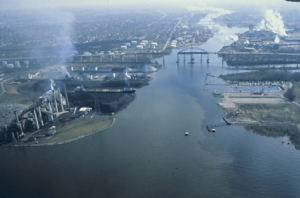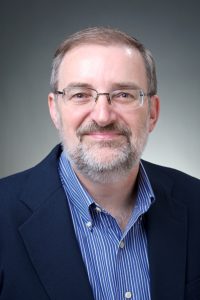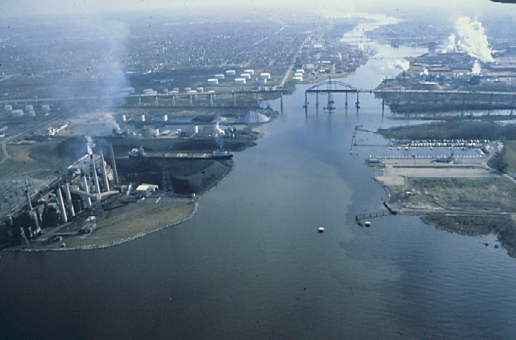WRI Contributed to Fox River Effort
Nov. 6, 2019
by Moira Harrington

For three decades beginning in the 1950s, seven Fox River Valley paper mills manufactured or recycled carbonless copy paper. Like so many processes and products of the modern world, carbonless copy paper represented human ingenuity. Multiple copies of documents could be created at a single stroke and the paper ensured information accuracy because no errors would be made as a result of marking up documents one by one.
Yet, like many other modern innovations, carbonless copy paper left a dark legacy. It came in the form of 250,000 pounds of polychlorinated biphenyls (PCBs) released in the production process, which contaminated 11 million tons of Fox River sediment. At the time, PCB use was unrestricted because the deleterious health effects—as a probable carcinogen, according to the U.S. Environmental Protection Agency (EPA), as well as impacts on the nervous, immune, circulatory and endocrine systems—were unknown. PCBs also affect wildlife and fish. Since 1976, there have been PCB-based fish consumption advisory notices for the Fox River and Green Bay system. In 1976, the EPA banned the manufacture of new PCBs.
Now, fast forward to mid-November of this year. On a date to be determined, the carbonless copy paper and PCB story that began in the 1950s comes to a close. After 15 years and $1.2 billion expended, the contaminated-sediment cleanup effort that also relied on ingenuity—science-based ingenuity—will conclude.
Both the University of Wisconsin Water Resources Institute (WRI), and its sister program Sea Grant, contributed research prowess that informed the cleanup effort. For Sea Grant’s part, it involved foundational work on PCBs’ fate in an ecosystem as part of a landmark EPA-lead study, the first of its kind anywhere on the globe, which focused on the questions of the sources, persistence and effects of nutrients and toxic contaminants in the lakes. The work had been vital to the development of analytical methods, data and expertise on the sources and behavior of PCBs in Great Lakes water, sediments and fish, and their health effects on people who eat the fish.
Water Resources Institute research
On the WRI side, James Hurley chaired the Fox River Remediation Advisory Team that in 2000 released results from a demonstration study of hydraulic dredging of contaminated sediment. From 1998-99, Hurley said, “In 32 days, nearly 38 pounds of PCBs and five pounds of mercury were permanently removed from the Fox River. This is a substantial amount that will not be transported downstream to Green Bay (Lake Michigan) and possibly enter the food chain.”

By the late 1990s and early 2000s, according to the EPA, the majority of the original PCB discharge had already entered Green Bay. On average each year, 600 additional pounds was moving from the river to the bay.
During these years, responsible paper manufacturers, citizen groups, scientists and management agencies conducted numerous conversations about risk assessment, and analyzed cleanup alternatives and/or environmental engineering design work. Some wanted to cap the sediments in place, others said to dredge.
In a 1998 interview with the Green Bay Press Gazette, respected University of Wisconsin-Green Bay professor and now Sea Grant Advisory Board member H.J. “Bud” Harris stressed that science could lead the way in breaking the gridlocked discussion about whether to dredge or not. He acknowledged that while science does not provide all the answers, it does offer direction. He noted the paper mills had been choosing to exploit uncertainty surrounding dredging and use it as an argument against the practice. “Dredging will disturb things but the point of the matter is that dredging will remove the mass of PCBs,” Harris said.
The Wisconsin Department of Natural Resources (DNR) eventually proposed six cleanup strategies involving versions of dredging or capping. A suction dredging method prevailed and the approach began in earnest in 2009. It will wrap up in November and come in at a cost of a $1.2 billion. It’s been termed the largest PCB cleanup in the world.
Cleanup, and beyond
The most contaminated spot, between the De Pere Dam and the bay, contained 86% of the river’s PCBs and that’s where the final leg of the cleanup took place. Just prior to completion, 10 miles of piping stretched from the river to a processing plant where water has been squeezed out of the sediment, cleaned and returned more pristine than when it left.
No sediment has been returned to the river. If it was cleaned sufficiently to have only a low level of remaining PCBs, it was beneficially reused. Sand from the river, for example, helped rebuild state highways 42 and 29. If the sediment still contained risky PCB levels, it headed to a secure landfill in the form of pressed cakes. The disposed amount will end up totaling more than 150,000 truckloads, enough to fill Lambeau Field seven times over.
Since river mitigation got underway, the fish population has improved noticeably. This fall, a DNR spokesperson said PCBS have declined 98% in gizzard shad, 88% in carp, 68% in the prized game fish walleye and 65% in smallmouth bass.
Along with the paper mills, other entities working directly on cleanup have included the EPA, DNR, U.S. Fish and Wildlife Service, National Oceanic and Atmospheric Administration and the Menominee and Oneida tribes. Others who contributed expertise include the Wisconsin Department of Health Services and the Agency for Toxic Substances and Disease Registry.
Looking toward the future, the DNR said it will continue to monitor PCBs for the next 30 years. For Sea Grant, the experience continues to shape investments in the Fox-Wolf-Green Bay ecosystem.




